Perhaps it’s a Midwestern thing, I don’t know. I grew up outside Chicago (although my family is mostly all from back east) so that’s where my theory originates regarding it being a Midwestern thing. After all, when I was growing up, nobody around me seem to think that it was odd so my assumption is that they all – we all – pronounced it this same way: “new-que-lar.” It was only later, when removed from the wayward influences of my isolated rustic upbringing was it pointed out to me – sometimes amidst unsuppressed laughter – that the word is spelled “n-u-c-l-e-a-r”. Or, in other words, it is pronounced: “new-clear.” Okay, so, whatever.
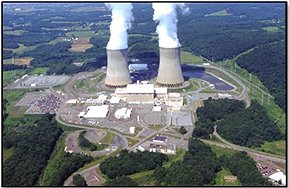 If I’m talking about ‘nuclear this’ or ‘nuclear that,’ what’s shown in the picture above is probably what popped into your head. And that’s fair. This is the way that nuclear power most commonly impacts our daily existence, i.e., through the light switches and electrical outlets in our houses that are ultimately traceable back to a power plant, some of which are based on nuclear fission reactors. Below are a couple of other applications of nuclear power with which we are familiar.
If I’m talking about ‘nuclear this’ or ‘nuclear that,’ what’s shown in the picture above is probably what popped into your head. And that’s fair. This is the way that nuclear power most commonly impacts our daily existence, i.e., through the light switches and electrical outlets in our houses that are ultimately traceable back to a power plant, some of which are based on nuclear fission reactors. Below are a couple of other applications of nuclear power with which we are familiar.
 Okay, so what does this have to do with rockets? Well, there are ways to use nuclear power to create rocket propulsion. And, by the way, this is not some newfangled idea out of the blue. Did you know that one of the original plans for the third stage of what would become the Saturn V rocket was for that stage to use nuclear-thermal propulsion? That plan was eventually dropped and a configuration using a J-2 engine was chosen instead, but going all of the way back to the late 1950’s people were thinking of ways to use the extraordinary power of nuclear fission to enable and enhance space exploration.
Okay, so what does this have to do with rockets? Well, there are ways to use nuclear power to create rocket propulsion. And, by the way, this is not some newfangled idea out of the blue. Did you know that one of the original plans for the third stage of what would become the Saturn V rocket was for that stage to use nuclear-thermal propulsion? That plan was eventually dropped and a configuration using a J-2 engine was chosen instead, but going all of the way back to the late 1950’s people were thinking of ways to use the extraordinary power of nuclear fission to enable and enhance space exploration.
There are two basic classes of rockets that use nuclear fission. One is called “nuclear-electric” and the other is called “nuclear-thermal.” In a nuclear-electric rocket, you use the reactor to generate electricity (like a small power plant) and then use that electricity to make high-velocity ions. The latter portion of the sequence is called “ion propulsion” and there are different schemes and ideas out there, some of which have been used on unmanned spacecraft in the past using other sources for electrical power.
Nuclear-electric propulsion is extremely efficient. In the past we’ve talked about specific impulse being a measure of rocket efficiency. Well, a nuclear-electric propulsion system is on the order of ten or twenty times more efficient than your typical high-performance liquid hydrogen / liquid oxygen chemical propulsion rocket such as J-2X or RS-25. BUT (and this is a really, really big “but”), for all that efficiency, they don’t generate much thrust. AND they are very heavy. Thus, the only place where using nuclear-electric propulsion makes any sense is in space. Even there in “weightless” space, the extremely low thrust-to-weight ratio means that this propulsion system is only appropriate for missions where you’re willing to be very patient and get to wherever you’re going quite slowly. That’s not really an appropriate approach for missions with humans on board.
The other class of nuclear power rocket engines, and the one that I really want to tell you about, is nuclear-thermal rockets. It is appropriate that we discuss nuclear-thermal rockets in an article immediately following an article discussing expander cycle engines since they are actually closely related. Almost cousins. Below is a schematic for a nuclear-thermal rocket in the same general format as the various expander cycle engines were shown in the previous article.
What you don’t have here is any oxidizer. Why? Because there is no combustion. In a normal rocket engine we use fuel and oxidizer in a chemical reaction to create hot combustion products. It is the ejection of those hot combustion products generate the engine thrust. For a nuclear-thermal rocket engine we use the reactor to make the hot stuff. You can think of the reactor, when operating, as a really, really powerful heat source, even more powerful than a chemical reaction. Thus, I can use that heat source to generate turbine drive gas, just as in an expander cycle engine, and I can also use that heat source to make the hot gas that generates the engine thrust. In terms of configuration, the reactor has built into it flow passages where the fuel picks up heat as it goes along. These passages can be along the outside, which I’ve shown here as feeding the turbine, and they are throughout the innards of the core. There are different ways of accomplishing this. One way is to make extrude the core rods with passages – “coolant channels” – through the length of the rods. This is shown in an old sketch from the NASA archives below. Another way to achieve this is to make the core out of pellets or “pebbles” trapped in little cages. Doing this, you’d get what’s called a “pebble-bed reactor” and such a configuration provides for lots and lots of heat exchange surface area between the core pellets and the working fluid flowing through.
So, what’s the “fuel” in the rocket schematic, i.e., the working fluid shown in red? The typical answer is hydrogen. One of the reasons that we use hydrogen in a chemical engine is because when we run fuel-rich, we get lots of hot, unreacted hydrogen as part of the exhaust. Hydrogen is very light. When it gets hot and energetic – and hydrogen picks up heat wonderfully – it moves very fast. If you think back to the rocket equation, fast moving exhaust means high performance. In this case for the nuclear-thermal rocket, the exhaust is pure hydrogen, so performance can be quite high. How high? Well, it’s not as high as the nuclear-electric options discussed above, but specific impulse values two times that of J-2X or RS-25 are entirely plausible. Further, despite the fact that nuclear-thermal engines are quite heavy, their thrust-to-weight ratio is generally much better than the nuclear-electric options. In other words, a nuclear-thermal engine has some good “oomph,” enough oomph to make it potentially usable for human spaceflight. And that’s why it was seriously contemplated in the earliest planning for the mission to the moon over fifty years ago. That’s also why, in my humble opinion, it is a prime candidate for any future human mission to Mars.
As mention above, this is not a new idea. It reaches all of the way back to the 1950’s. There was a series of active programs all throughout the 1960’s falling under the general heading of NERVA, Nuclear Engine for Rocket Vehicle Application. Below is a picture of an actual test of one of these engines.
So, with all this history behind us and with all this potential for performance, why on earth haven’t we been pursuing this technology first and foremost? Because, well, nothing is free and nothing is ever as easy as it seems at first.
The biggest struggle with nuclear-thermal rockets is that whole radiation thing. Okay, yes, I said it. Radiation is bad. Deadly. And very long-lasting. While rocket engines of any type always pack a punch in terms of power density and, therefore, the possibility for catastrophe, with the added spice of radiation, you’ve got quite the potential for a noxious stew. Does this mean that we ought to simply avoid it altogether? That’s a valid question and one that’s been debated for about 50 years. It would be presumptuous of me to suggest that I could resolve the issue definitively, but we can discuss the constituent elements rather than just falling back on the “radiation is scary” answer.
First, let’s talk about whether it could be used on a vehicle. The reactor is going to generate radiation. Internally, that’s how it works and that radiation in different forms overflows the boundaries of the reactor. It just does. So, what do you do? Well, you provide shielding. The truth is that space is chock full of radiation. If not for our little pocket of safety thanks to the magnetic poles of planet earth, we’d be cooked to the crisp by the radiation pouring out of the sun. When you’re in space, particularly if you’re going beyond our little planetary pocket of safety and traveling to the moon or to Mars, you’re going to get bombarded by radiation so no matter what, shielding is necessary. Shielding is heavy because in order for it to be effective, you need big, heavy molecules to catch gamma rays (my very simplistic explanation). Lead and tungsten are two common shielding materials for this purpose. With a fission reactor, you are also going need something for neutron flux moderation. The typical material for this is Lithium Hydride but the propellant tank itself containing hydrogen also works well for this.
A means for minimizing the weight impact for the shielding used to protect the astronauts from the reactor radiation is to use the notion of a shadow. In the sketch below, you have a reactor on the back end of the vehicle, a shield in between, and the spacecraft up front. Between, connecting everything and not shown, would be the propellant tank and the usual shiny structural trusses. As you can see, the shielding creates a shadow from the radiation within which the spacecraft sits. Now, it’s not always this simple because you sometimes need holes through the shield for functional reasons or you could get reflected/scattered radiation effects from structural elements, but this is the most common general scheme for dealing with a reactor on a spacecraft. Stick the reactor out a ways from everything, place the shield close, and cast a long, broad shadow.
Okay, you say, you’ve protected the astronauts, great. But what about the six or seven billion people back here on planet earth? After all, in order to fire up a nuclear-thermal rocket in space you first have to get it into space and that means that you have to launch it from the surface of the planet. Launch always involves risk. What happens if the launch vehicle blows up? If the launch vehicle blows up, then the reactor blows up. Wow. Now, how dangerous is that? I will not pretend that I can answer that question with my limited background. But I can tell you that prior to and during launch, the reactor is “cold.” While you probably wouldn’t want to use enriched uranium to make wallpaper for your house, it’s not that horrifically dangerous prior to use in an active reactor. It is only after the reactor gets going that the innards get all juiced up and seriously radioactive. The plan would be to launch the reactor never having been “juiced up” and only start it when it is at a safe distance from earth thereby eliminating as much as possible the potential of reentry of a hot, radioactive reactor into the atmosphere.
[Note that the fact that you need something like tungsten for a shield (very heavy metal) and you’ve got bundled up uranium in your reactor (another even heavier metal) are big reason as to why a nuclear-thermal rocket engine is typically so heavy as compared to a chemical rocket engine.]
The next issue to deal with for a nuclear-thermal rocket is probably one of the most difficult: testing. On the one hand, we’ve got lots of places where we can test rockets. On the other hand, we have certain places where we test reactors (mostly under the expert supervision of the Department of Energy in coordination with the U.S. Navy). But putting those two pieces together and playing with them as a unit, now that’s really tough. Why? Because of that darn radiation thing again.
After a typical J-2X or RS-25 test, after we’ve cleared residual propellants and bled away any excessive pressures, we’ve got technicians all over those engines. They’re inspecting this, examining that, taking things apart, putting them back together. The whole point of a development program is to get data and a lot of that data comes in the form of post-test inspections. With a nuclear-thermal rocket, that wouldn’t be possible unless you really, really didn’t like your techs (please note that’s not serious, just a joke in poor taste). Once the reactor has been fired up, it’s hot. Yes, you can dial it back down so that it’s no longer at fully throttle, but both it and the surrounding stuff are contaminated to some extent with radiation. And you don’t just wipe radioactivity away with a damp rag. After that first initiation of self-sustaining chain reaction (i.e., “critical”), everything needs to be handled very differently. Also, in addition to this, the hydrogen working fluid that we push through the reactor, it too picks up some level of radiation. No, not a lot. But under modern safety restrictions, all of that hydrogen would have to be captured and scrubbed clean before release. Capturing rocket exhaust is not an easy job. It’s possible but it requires some extraordinary test facility capabilities.
With all this difficulty, how can we conceive of getting through a development program? A rocket engine development program requires testing because, frankly, we are demonstrably not smart enough to do without it. One answer: Split the engine into two pieces. If you do the rocket part separate from the reactor part, then you can keep the two pieces blissfully in their natural environments, i.e., the rocket part on NASA test stands and the reactor part in the Department of Energy labs. Focusing on the rocket side (not surprising for me, eh?), the difficulty then becomes in simulating the heat source that is the reactor. There has been some work done here at NASA MSFC at creating reactor simulators specifically for the purpose of testing subsystem separate from reactors whether those subsystems are rocket engines or power generation systems. Below is a picture of one such reactor simulator.
In this manner you can minimize or possibly even eliminate for the combined rocket/reactor testing that is so difficult to pull off.
Before nuclear-thermal rockets can be used on missions of the future, there are a number of challenges to overcome, but the potential gains in vehicle and mission performance are impressive. While this topic doesn’t fall entirely within the realm of liquid rocket engines consistent with the title of this blog, I thought that the similarity of the schematic to expander cycle engines would be of interest. In this case, rather than a chemical reaction, you have nuclear fission, yet the engine cycle is still a matter of driving a fluid into a place where it gets hot and, from there, is ejected at high velocities. In this way, a rocket is a rocket is a rocket, even if it is “nu-que-lar.”


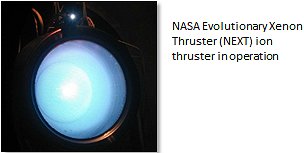
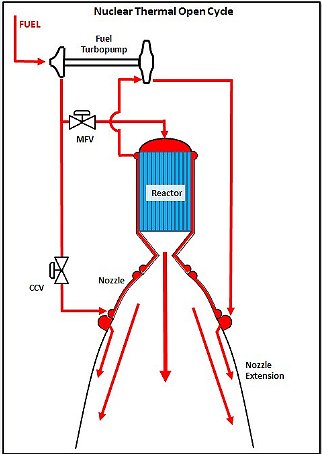
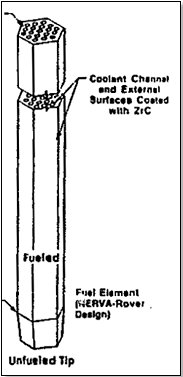



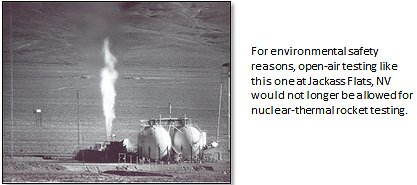
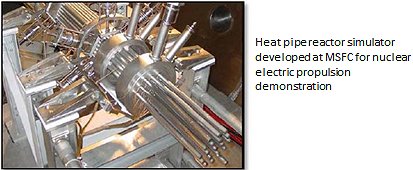
You need to expand the space station and rotate it for gravity.Also make a space dock to build these new ships.Be nice if you could use methane as fuel,because its abundent.
If you’re just heating a gas without it being in a chemical reaction, couldn’t you use something like Nitrogen? Abundant, relatively inert, much higher density for storage, and much more mass to be able to eject at high speed = higher thrust (for the same eject velocity). The ION engine used Xenon for essentially the same thrust and storage density gains.
But it does hark back to the USAF interest in a nuclear bomber. Some good footage of that on YouTube.
Russell
I actually interned at Marshall this past summer and we were working on an NTP engine. It was a lot of fun. 🙂
@Nathan: Yes, methane would make a very good fuel. There are a number of people and organizations who have made such suggestions in the past, but nobody has yet followed through with building a practical CH4/O2 rocket engine. Cryogenic methane as a quirk or two that make is a little odd to handle, but if those are overcome then there’s much promise. In terms of performance, it’s better than kerosene. In terms of packaging, it’s better than hydrogen. It’s kind of in between the two and so it might enable some interesting missions.
@Russell: Very good question. It basically comes down to molecular mass. While it’s been a few years since I’ve played with it, I still have on my computer the old NASA-Lewis Chemical Equilibrium Program CEA from Bonnie McBride and Sanford Gordon. If I stick into that 3000F hydrogen and 3000F nitrogen (and fooling the program just a little in order to make it work) and simply expand it out to a 245:1 expansion ratio, then I get a vacuum specific impulse of about 759 seconds for GH2 and about 208 seconds for GN2. At a given temperature, the lighter molecules of H2 are going to be flinging themselves into space at a much higher velocity. That higher velocity translates to a more efficient momentum transfer via the rocket equation.
I tried to mention this consideration in the article itself with the reference to the fact that we run H2/O2 engines fuel-rich but perhaps the connection wasn’t clear. Think about the H2/O2 reaction. At perfect stoichiometric, mixture ratio = 8, your combustion product is H2O (water/steam). At lower mixture ratios, you primarily get a combination of H2O and H2 as the constituents of your exhaust. Now, at stoichiometric conditions, you get your hottest fire, so people naturally assume that that’s where you get your best performance. But that’s not true. The peak specific impulse for an H2/O2 rocket, depending upon chamber pressures and cycles, is somewhere between a mixture ratio of 3 and 4. Why? Because while it’s not the hottest fire possible, I have so much more extra H2 flinging itself at high velocities that I actually get a more efficient momentum transfer despite the overall cooler temperatures. The H2 molecules are much lighter than the H2O molecules.
However, as you mention, liquid H2 is very un-dense (fluffy) and a nuisance with regards to packaging. Thus, most launch vehicles that use H2/O2 are sized to a mixture ratio of somewhere between 5.5 and 6.0. That’s still fuel-rich as compared to the stoichiometric value of 8 so you get some of the “free H2” advantage, but it’s not at the best theoretical performance point on the curve. It turns out that a mixture ratio in this range is generally the best compromise between specific impulse performance and vehicle packaging considerations.
Great to see this technology still being discussed and tested. Just how likely is it that we will see a NTR stage for in space propulsion for a future NASA human flight to Mars? I have read it was an option in a previous Mars DRM and the advantages over chemical propulsion were very clear, seems almost a shame not to use the technology. Can we just build and use the NTRs developed back in the 60s or are they too obsolete to even consider using now?
This might be a rather silly question, but thinking about all that H2 leaving the rocket unoxidized made me wonder whether a hybrid chemical/nuclear rocket has ever been considered. For example, could you feasibly construct a sort of “afterburner” where O2 was injected into the nuclear-thermal exhaust to give a bit of an extra kick, and would it be worth the additional mass? Alternatively, could you use a smaller nuclear-thermal component for an element of a traditional chemical rocket – such as replacing the gas generator?
@Ben: It’s been ten years since I was directly involved with this technology. Back then, we were looking forwards through the lens of the aptly named Prometheus Program and, yes, it seemed like a plausible direction we’d be heading. But, programs come and go. The technology (i.e., the physics), on the other hand, mostly remains the same. Thus, the bottom line that nuclear-thermal propulsion is attractive for a Mars mission is undeniable no matter what program symbol is painted on the hardware.
The technology that we tested back in the 60’s is, largely, the same technology that we’d use today. What would be different on the rocket side is our knowledge of dealing with hydrogen in general, which was still a somewhat new-fangled propellant 50 years ago, and our standards and techniques applied to analyzing and manufacturing the hardware. Frankly, considering some of the extraordinary engineers I know here at NASA MSFC, designing and building the rocket side of a nuclear-thermal rocket would be like falling off a log. Yes, it would require some work, as all worthwhile things do, but there’s nothing there that should be stretching our capabilities.
Now, on the reactor side, I’m not quite as knowledgeable. Back ten years ago one of the biggest concerns was reactor fuel development. It was suggested then that once you choose your launch date that you needed to back up about 10 to 15 years prior to that date and start funding this development activity. That kind of long-term vision and commitment is obviously an extremely difficult narrative to sell, initiate, and maintain in an environment of annual appropriations fights.
And, of course, as I mentioned in the article, one of the biggest struggles with the technology is system-level testing. Even if the rocket side design is akin to falling off a log for experienced rocket engineers and even if we get ourselves in good shape with regards to reactor technology, the question remains, how do we test these things such that we can certify them for flight? And, that issue of flight certification is dramatically amplified if you plan on flying people. Can it be done? Emphatically: Yes. And safely. But not cheaply or quickly. This is another facet that requires a long-term vision and steadfast commitment.
@Karl: That’s not necessarily a silly question at all, but my tentative answer kind of sounds similar to the response above to Russell. If I run CEA with 2000K hydrogen and nothing else (other than a trace to make the program run) at 1000 psi chamber pressure and a 200:1 nozzle, I get a specific impulse around 770 seconds. However, if I take that 2,000K hydrogen and mix in some oxygen to a mixture of, say, 2:1, yes I do get an even hotter mixture, but my characteristic velocity (c-star) goes down due to the effect of the heavier average molecular weight. The specific impulse drops down to the range of 610 seconds. However, I realize that by doing the calculation the way that I have it’s not really applying the oxygen in an after-burner mode as you suggest, so maybe there might be something there that I’ve lost. It might be something to at least consider looking at more closely.
Okay, a back to basics question: Specific Impulse is a measure of efficiency of the engine, but thrust is what does the work, isn’t it? So while throwing H2 out the back at high speed gives higher efficiency, wouldn’t H2O, or CO2 give higher thrust? Karl’s suggestion adds mass and additional heat energy to the exhaust, so logically more thrust (or so it would seem to me). Or is thrust less important in the microgravity of space than on the ground trying to get into space?
This has been considered, and it’s called a LANTR. (LOX-augmented nuclear thermal rocket) There’s an Aerojet document floating about somewhere. I don’t recall if they did the non-nuclear tests mentioned in the paper or merely proposed them, but going from memory I think it involved something like a 20-30% isp loss and a 50-100% thrust increase. (!)
If you took an optimistic Timberwind-style pebble bed NTR, and again took the optimistic upper bound of Aerojet’s LANTR testing, you could conceivably get an NTR that could almost compete with LH2/LOX chemical rockets and still have isp similar to the 60’s NERVA. You’d basically get an NTR with sort of gears, you could run higher thrust/lower isp with LOX and vice versa without.
For somewhat safer nuclear reactors, thorium could be used as the nuclear fuel instead of uranium. The fission products for a thorium reactor would decay away much faster than those for uranium. The thorium nuclear reaction is not suitable for creating explosions so proliferation should be less of a problem.
Nuclear reactors can provide copious amounts of energy for long periods of time. However, rockets still need to carry sufficient propellent to complete a mission. H20 may not be the best propellent but it is easily found in the form of ice on many celestial bodies. Nuclear rockets might help solve this logistical problem.
@Russell: Yes, one can think certainly of thrust as “doing the work” in the Newtonian sense. You are absolutely correct. However, when you’ve got not much else working against you, as is the situation in space, your efficiency in thrust generation (i.e., your specific impulse) is much more important than brute force.
Here are the basics in a very simplistic sense for rocket propulsion: (1) when getting off the planet, thrust is king; (2) when moving about in space, specific impulse is king.
When you’re on the planet and trying to get off, you have a couple of very significant things working against you. First, you have gravity. It takes a lot of oomph to get a vehicle up and away from the planet, i.e., out of the “gravity well.” That’s why using lower efficiency propellants such as kerosene and solids is extremely useful for the first stage of launch vehicles (think of the first stage of Saturn V or the big solid-propellant boosters on Shuttle and SLS). Second, you have to deal with the atmosphere and all the energy losses associated with drag. Again, the faster that you get up, away from, and out of the atmosphere the better. Thus, going back to Newtonian thinking tells you that big thrust results in big acceleration. From there, basic kinematics tells you that big acceleration means fast transport. Therefore, big thrust translates to minimizing the losses caused by near-planet effects.
Now, after having escaped from the atmosphere and having achieved orbital velocity, you’re hanging around “weightless” in space. So, how do you go somewhere else? Well, again you need to accelerate (in orbital mechanics jargon you need “delta-V”), but you don’t necessarily need to accelerate quickly. You’re no longer fighting to get away from the surface of the planet. This is why you can use things like nuclear-electric or solar-electric propulsion systems, which are typically extremely low-thrust options. Yes, Newton still applies: you need thrust to get acceleration. But, you have to remember that with a space vehicle, you’re carrying everything with you. The efficiency of your propulsion system relates directly to the sizing of your overall vehicle. An inefficient thrust generation system means that you need really big propellant tanks. Really big propellant tanks are heavy. Heavy stuff takes more energy to accelerate. And thus you can imagine the compounding effect of lower efficiency thrust generation, i.e., lower specific impulse.
If you go all of the way back to an article published here in March 2011 you can find a discussion of the mathematics (and calculus) behind this conversation in the form of the “Rocket Equation.”
When you’re talking about nuclear thermal rockets, you’re usually talking about in-space propulsion. Yes, on rare occasions folks have proposed using nuclear thermal rockets for earth-to-orbit propulsion, but most people are not comfortable with hot reactors being flung around in the atmosphere. So, if you’re talking in-space, then thrust generation efficiency is going to be the key. While some of the ideas presented here could boost thrust, they don’t necessarily increase efficiency. And, in some cases, there’s an additional penalty in terms of vehicle weight.
That last point is an interesting one, FYI. The largest part of any launch/space vehicle is propellant storage. That’s an interesting thought. On the front end of a vehicle is complex stuff called your payload. On the back end of a vehicle is complex stuff called your engines. Your payload is your objective so it weighs what it weighs. Your engines weigh a lot, within historical norms, but considering the internal conditions of pressures and temperatures, that’s not surprising. In between these two complex ends are essentially huge aluminum cans called your propellant tanks. The more efficient you can be with this storage of propellants in terms of dry, structural mass versus the mass of your stored propellants, the more successful will be your vehicle. What’s the most efficient structure? One great big hollow shell is quite efficient and that fits the notion of nuclear-thermal propulsion and the use of hydrogen as a single propellant. For a bi-propellant chemical rocket, I cannot use one hollow shell. At the very least, I need two big hollow shells. In terms of the ratio of dry mass to stored propellant mass, I’ve just become less efficient in terms of stored propellants. Now, over the years there have been various tri-propellant rocket engine ideas have been put forward and a couple were suggested here as well. Some are really, really cool and have neato theoretical advantages. But now, if I were to use such a system, I have to store three propellants. My ratio of dry, structural mass to useable propellant mass now just got really bad with three separate storage tanks. This is one of the reasons that tri-propellant rockets have, to date, been research projects rather than practical designs.
All these considerations go into the conceptual designs for launch architecture and mission designs. It’s always a tricky matter of balancing between various pros and cons.
Thanks for the clarification. Amazing how a second, slightly different explanation helps the first sink in.
Want to explain why we have politicians now? 🙂
@Stephan: I understand how reactors work on a very basic level, but I am by no means a nuclear engineer or nuclear physicist. Your comments regarding Thorium are interesting. Perhaps I’ll do some research for my own edification.
And, yes, I like your idea regarding the use of nuclear-thermal propulsion with in-situ resources. When I think of nuclear-thermal, I am typically thinking like an engine guy and, as such, I’ll default to high performance and hydrogen as the obvious propellant choice. But taking into consideration overall mission efficiency, the use of extraterrestrial fluids might have distinct advantages even if your specific impulse suffers. Very interesting thought.
Taking a step back, that’s always been the problem with space exploration as compared to the great exploration missions of our historical past. When sailors from the Old World arrived in the Americas four hundred years ago, there was lots of stuff that they didn’t have in this new place but there was no question that what they found was lots and lots of raw materials. There was food and timber and metal ores and, certainly at the very least, air and water. The Moon or Mars or Titan doesn’t offer such an abundance of resources. But the degree to which we can utilize what these places do have will help us immensely.
If we’d gone ahead with Project Orion, we could’ve got to the nearest star by now.
Late to the party, but I wanted to point out that thorium would indeed make a rocket propulsion reactor much safer by preventing it from actually working. Like U238, thorium is fertile; it is far more likely to capture neutrons and eventually transmute to a fissile isotope (Pu239 or U233 for U238 and Th232 respectively). The promise of thorium is as a feedstock to breeder reactors to produce U233 which could be used in space reactors much as U235 (the active ingredient in HEU) has been used in the past.
This adds an added element of risk: U235 and U238 are the dominant natural occurring isotopes of uranium because they have much longer half-lives (i.e. are less radioactive) than U232 and U233. HEU is made by concentrating U235 from natural uranium. It’s not appreciably more radioactive than natural uranium; it’s about as dangerous as lead provided it doesn’t begin to fission. By contrast, U233 is extracted from irradiated nuclear fuel. The purification process in’t perfect so there is some amount of U232 in with the U233. That poses a problem because U232 has a really short half life (~70 years vs hundreds of thousands of years for U233, U235, & U238 and it decays to gamma emitters which make it difficult to handle.
So even if you migrate to a thorium fuel cycle for some reason and use U233 for your reactor fuel, you are worse off from a safety perspective than using a clean cold core of U235/U238.
Also, assuming the argument about actinide and fission product longevity is valid, it’s not really a concern for a space reactor which may have a mission time of a few years. It’s a concern for terrestrial plants but the main radiation risk in space is direct shine from an operating reactor (as explained very well in the original post), not radiation from activation & fission products.
I appreciate the interest and enthusiasm people have for thorium, but it really helps to move beyond the hype, learn some basic reactor theory, and understand the characteristics of the dozen or so fissile and fertile isotopes. There are a very limited number of materials suitable for reactor fuels, especially in specialized demanding roles like space power systems and rocket propulsion. It seems like forever ago in grad school learning about NERVA, SNAP-10A, SP-100, the Russian TOPAZ reactor and their other space reactors used on naval reconnaissance satellites (e.g. COSMOS 954). I highly recommend getting a copy of Space Nuclear Power (ISBN-13: 978-0894640001); though dated it’s still a fantastic intro to space power systems and nuclear power systems in particular.
Remember – the people who work on these systems are not stupid or shills for Big Uranium. If thorium was a viable option as a reactor fuel (not as feedstock for breeding) , it would have been heavily researched and prototyped. It wasn’t and there’s a very simple reason why: it won’t work. It would be really cool if it did, but physics doesn’t lie.
And yes, I actually am a nuclear engineer. But don’t take my word for it — get a used copy of “Space Nuclear Power” and a good intro text on reactor theory (Duderstadt, Lamarsh, or Glasstone & Sesonske). Look for the equations for calculating critical mass (diameter, really) and plug in the most optimistic numbers you can find for Th232. The results will be disappointing but they are what they are.